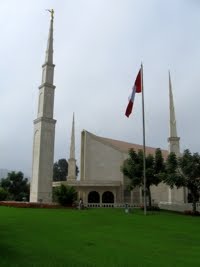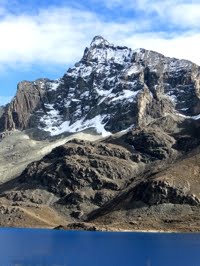Huancayo
At 6:30 pm, President and Sister Mendoza (he is 1st counselor in the Mantaro Stake presidency) picked us up at the hotel and took us to the Mantaro Stake Center, on the outskirts of Huancayo. Brother Mendoza is a Church Educational System director; Sister Mendoza worked as a chemical engineer before she got married and had children. Both of them speak some English.
Scott was the featured speaker at a stake fireside that night. His topic was "Becoming a missionary family." He used a PowerPoint presentation with pictures of families (including our own) who have done missionary work. The members loved the pictures and seemed to enjoy the presentation.
Afterwards, many people came up to talk to us. Some of them wanted their pictures taken with us. Here is a young man who is preparing to serve a mission, along with his parents:

Beverly was asked to accompany the stake choir, so some of the choir members wanted their pictures taken with us:

We also had our picture taken with the stake presidency and their wives. Next to us on the right are President and Sister Tupac Yupanqui (Tupac Yupanqui is the name of a famous Inca leader). The couple third from the left is President and Sister Mendosa. On the far right is the new second counselor and his wife.

The audience of approximately 180 faithful saints, was evidence of the "marvelous work and a wonder" that has taken place in Huancayo since it was opened to missionary work in 1964 during Scott's first mission.
Huancavelica
The next day, we traveled to Huancavelica for the sole purpose of doing a biannual financial audit--which we should have done two weeks earlier, but were never informed about until the day after we returned to Tarma!
Scott met with the district presidency and branch presidents. The district and branches are caring for the Lord's money in an appropriate and responsible way. They are wonderful, faithful leaders.
We look forward to going back to Huancavelica in three weeks for their district conference.
























































